Feature
Collaboration Through Critical Service Learning—In Search of Earth’s Secrets
Pedagogical Collaboration Through Community Engagement
Connected Science Learning September–October 2023 (Volume 5, Issue 5)
By Faye Bruun, Katherine Dion, Kimberly Moore, Robin Johnson, Cherie McCollough, and Carmen Tejeda-Delgado
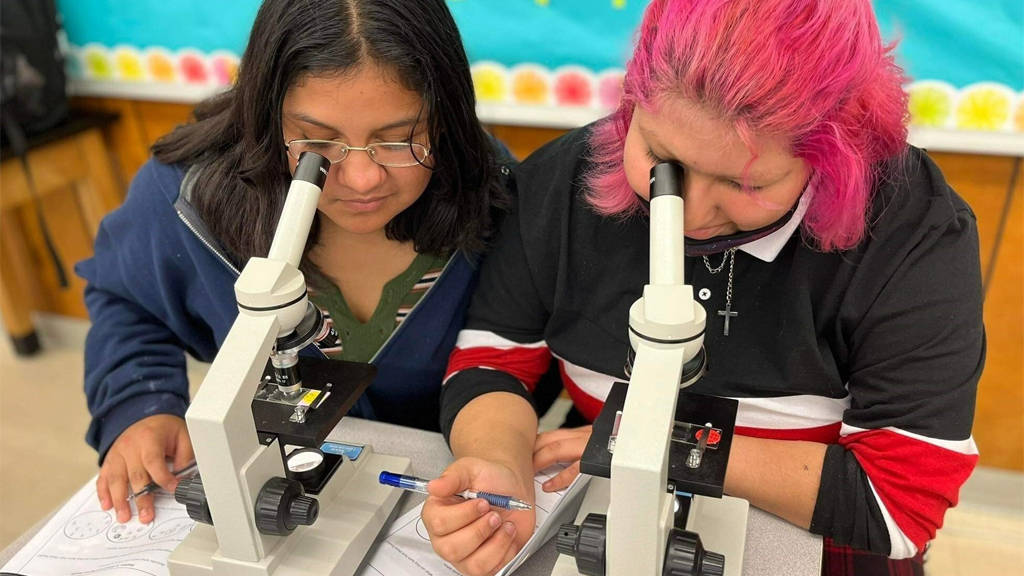
This article describes a series of middle school science teaching and learning programs involving a collaboration between West Oso ISD, Texas A&M Corpus Christi, and the International Ocean Discovery Program (IODP). Texas A&M Corpus Christi is a recipient of a National Science Foundation (NSF) Robert Noyce INSPIRES (Infusing Social Programs in Residential Education Scholars) educator preparation grant focused on providing secondary STEM teachers culturally relevant pedagogy for diverse student populations. The main goal of the NSF Noyce Scholarship program is to recruit, train, prepare, and retain highly effective elementary and secondary mathematics and science teachers (i.e., Noyce Scholar undergraduate teacher candidates) and teacher leaders in high-needs districts. The Noyce INSPIRES team consists of a Principal Investigator (a science education faculty member) and three co-Principal Investigators (faculty from the college of education), and the West Oso ISD teachers.
This program follows a model created to provide on-site, intentional community and field experiences within a collaborating Title I school district. The Noyce INSPIRES guiding purpose is to support an inclusive culture of STEM success by developing STEM talent and achievement through authentic and relevant experiences involving grades 7–12 students and teachers in economically disadvantaged urban schools. Our vision is for the university to develop culturally responsive STEM secondary teachers. Our Noyce INSPIRES–funded project is designed to infuse culturally relevant instructional pedagogy within the community, resulting in the development of a model that can be adopted/adapted in other Hispanic Serving and Minority Serving institutions. Through these academic and hands-on experiences, Noyce Scholars will develop a strong pedagogy with knowledge of culturally relevant teaching.
Critical Service Learning
Noyce STEM INSPIRES Scholars participated in education experiences that implement critical service learning projects, reinforcing STEM grades 7–12 education for underrepresented groups in high-needs schools. Critical service learning is different than traditional service learning with its three-pronged approach. First, the community learning component provides experiences with Community Mentors, university faculty with the Noyce INSPIRES team including West Oso ISD teachers that allows contextual awareness to unfold. Second, community-engaged teacher preparation emphasizes the elevation of funds of knowledge and community cultural wealth (Noddings and Brooks 2017). Funds of knowledge engage the power of community and forge relationships between school district stakeholders, teacher candidates, and key community members for teacher candidates to become agents of change in their communities (Ball 2019). Third, integrated curriculum involves topics that are explored thematically across content areas (Jeffery et al. 2015). Noyce INSPIRES included planning genuine celebrations of diversity that extended beyond cultural celebrations by intentionally and deliberately bringing citizens from different backgrounds together. Topics were connected to STEM subjects (McCollough and Ramirez 2012). Our work is designed to show that a culturally relevant approach to service learning results in more complex thinking and reasoning skills than traditional service-learning courses. This progressive pedagogical orientation requires educators to focus on social responsibility and critical community issues.
In Search of Earth’s Secrets
In the first year of the grant, the Noyce INSPIRES team was able to partner with the International Ocean Discovery Program (IODP) and the Corpus Christi Museum of Science and History on a critical service learning project benefiting the entire community. A local teacher who was a former director of educational activities for the IODP’s Deep Earth Academy was instrumental in bringing the NSF-funded, pop-up science exhibit In Search of Earth’s Secrets to West Oso ISD. The teacher worked aboard the IODP research vessel, JOIDES Resolution. The project intentionally requires the exhibit to travel to an accessible community site.
Founded over 50 years ago by a marine investigative collaboration of 22 member nations, the IODP is the leading scientific organization in deep-sea sediment core drilling. Their research teams onboard the R/Vs JOIDES Resolution, have amassed the world’s largest repository of deep-sea sediment cores where data has led to groundbreaking discoveries in nano- and micro-paleontology, subseafloor environments, and ancient Earth conditions and history (International Ocean Discovery Program 2022). Over the decades, the IODP has made dissemination and accessibility of its research to the general public a cornerstone of its mission. In Search of Earth’s Secrets travels around the country to bring exciting research and hands-on STEM activities to traditionally underserved communities (IDOP 2022). The exhibit includes six interactive kiosks, a 32’ × 16’ floor map, and a 46' × 30' × 20' inflatable replica of the JOIDES Resolution.
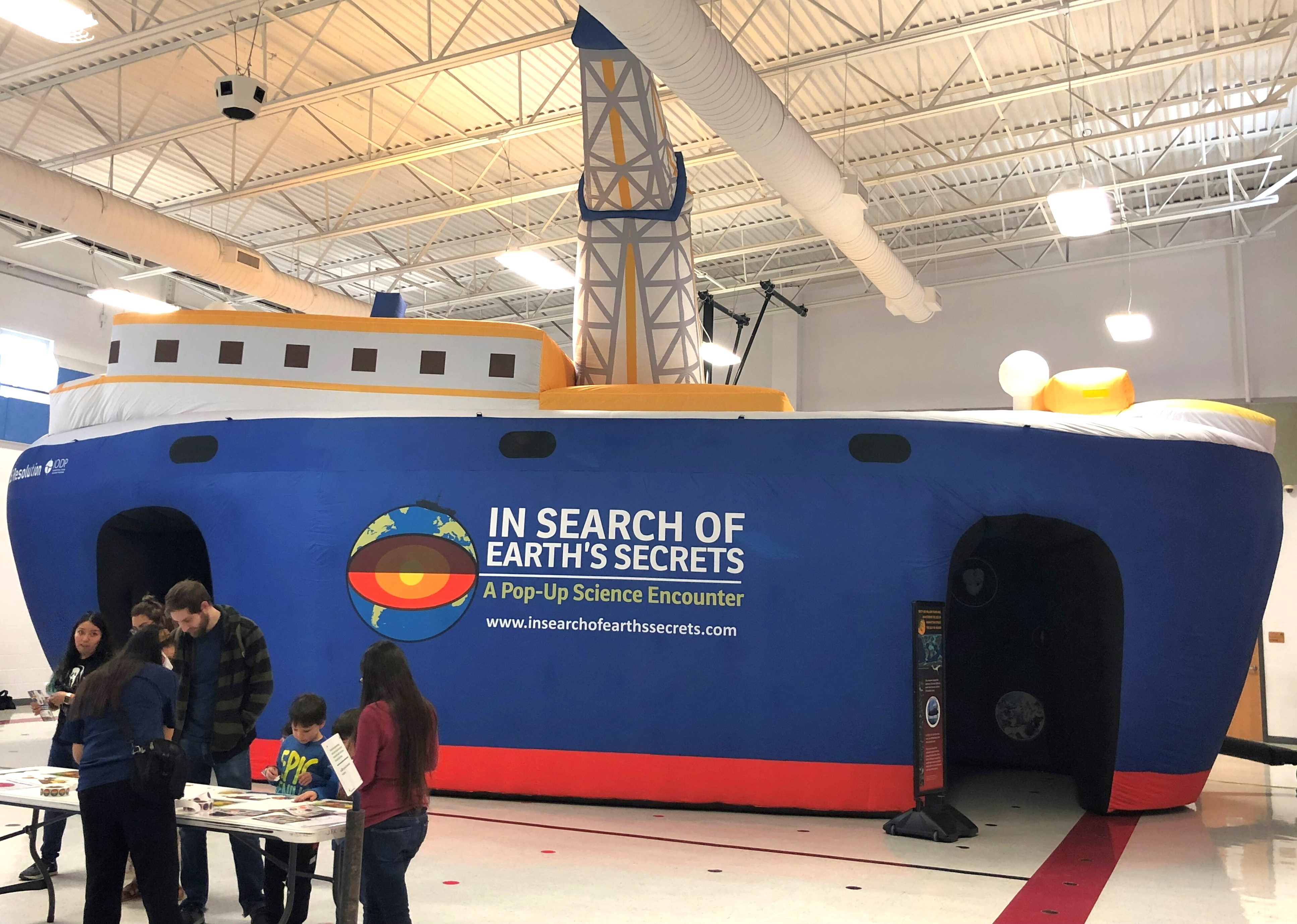
In early 2022 the traveling pop-up exhibit based on the IODP came to Corpus Christi where the Noyce Scholars and West Oso ISD cooperating classroom teachers facilitated activities for elementary and middle school children. Prior to the arrival of the exhibit to the school district, the Noyce Scholars and teachers attended a series of professional development trainings at the local museum of science and history to help the Noyce Scholars develop critical informal science teaching skills. These trainings covered a variety of topics and incorporated an introduction to the Next Generation Science Standard (NGSS) MS-ESS1-4 History of Earth. Activities included
- the ocean and Earth science research conducted by the IODP aboard the R/V Joides Resolution,
- hands-on training on creating sediment sample smear slides,
- STEM and related career paths, and
- how to lead informal science activities and lessons with young students.
During the professional development, the Noyce INSPIRES team led a series of informal hands-on activities and discussions with middle school female students who were part of an elective middle school STEM Academy. These discussions and activities were designed to give a robust idea of the different STEM research and fields encompassed in IODP work. Research has shown that active rather than passive student engagement is crucial to successful learning, particularly in STEM subjects (Freeman et al. 2014). This pedagogy is echoed by the National Research Council and the NGSS that call for students to develop scientific mindsets and be engaged in—not just learn about—true science and engineering practices (NRC 2015; NGSS Lead States 2013 p. xix).
The activities were developed by the Noyce INSPIRES project manager specifically with this guiding NGSS standard and pedagogy in mind. This Noyce INSPIRES team member is a previous participant in the IODP’s School of Rock intensive teachers’ training course. The activities covered recognition of key features in bathymetry and stratigraphy maps used in selection of drill sites, the global distribution of drill sites, identification of important nano- and microfossil species used in dating sediment core samples, and interactive digital tours of the ship and its specialized equipment. Discussions were student-led and encompassed the topics of how students thought scientists conduct investigations, the variety of STEM careers related to the IODP expeditions, and the importance of the research conducted by the IODP. The Noyce Scholars and the middle school STEM Academy students then completed a critical thinking activity that had them synthesize their newly acquired information. In small groups, they worked together in planning a proposed IODP future expedition. For their proposed expedition, they
- marked the location of their proposed drill site on a map of the Gulf of Mexico,
- developed a scientific question to investigate via the scientific method,
- determined the number of cores needed and the kind of data to be collected,
- identified what kinds of STEM professionals to collaborate with to analyze the data, and
- identified what challenges they might encounter and how to overcome them.
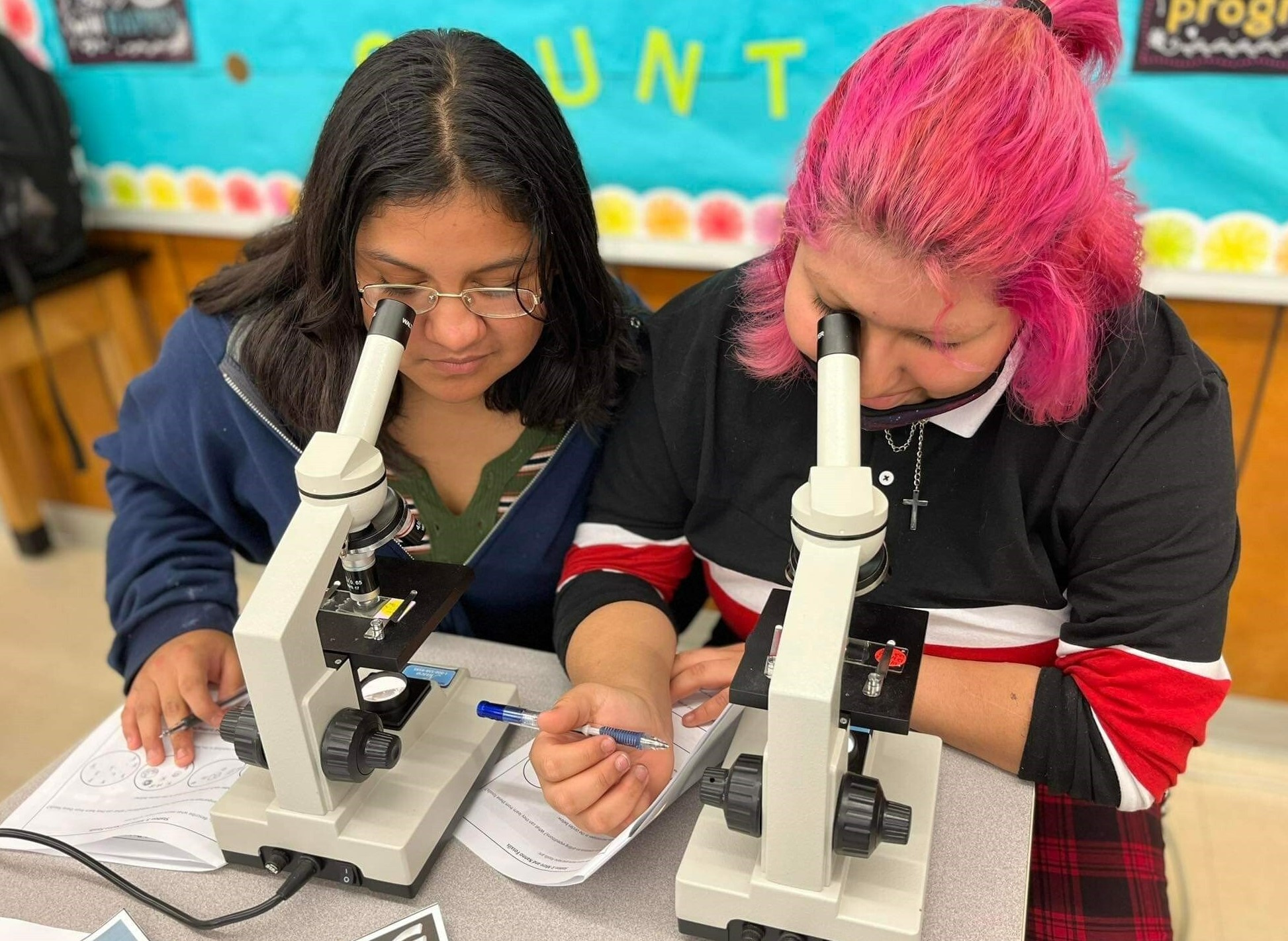
After attending professional development about the research conducted by the IODP, the middle school STEM Academy students and the cooperating classroom teachers were engaged in a hands-on activity that directly modeled a large part of the scientific work that occurs onboard the drill ship during every expedition. Participation in authentic STEM learning experiences that showcase real-world issues has also been identified as a major factor in building the positive self-perceptions of traditionally underrepresented students (Roberts et al. 2018). The students and teachers created professional, research-grade smear sample microscope slides. They used deep sea core sediment samples drilled on real IODP expeditions. Each middle school STEM Academy student made their individual slide; then examined it under a microscope. They identified nano- and microfossils present in their sample. The Noyce Scholars were also engaged in this activity, learning how they can lead future students in making their own slides.
The Noyce Scholars, middle school STEM Academy students, cooperating teachers, and the Noyce INSPIRES team learned alongside one another. The former director of educational activities for the IODP led this inquiry-based training, which provided all participants with direct contact to an expert in the field.
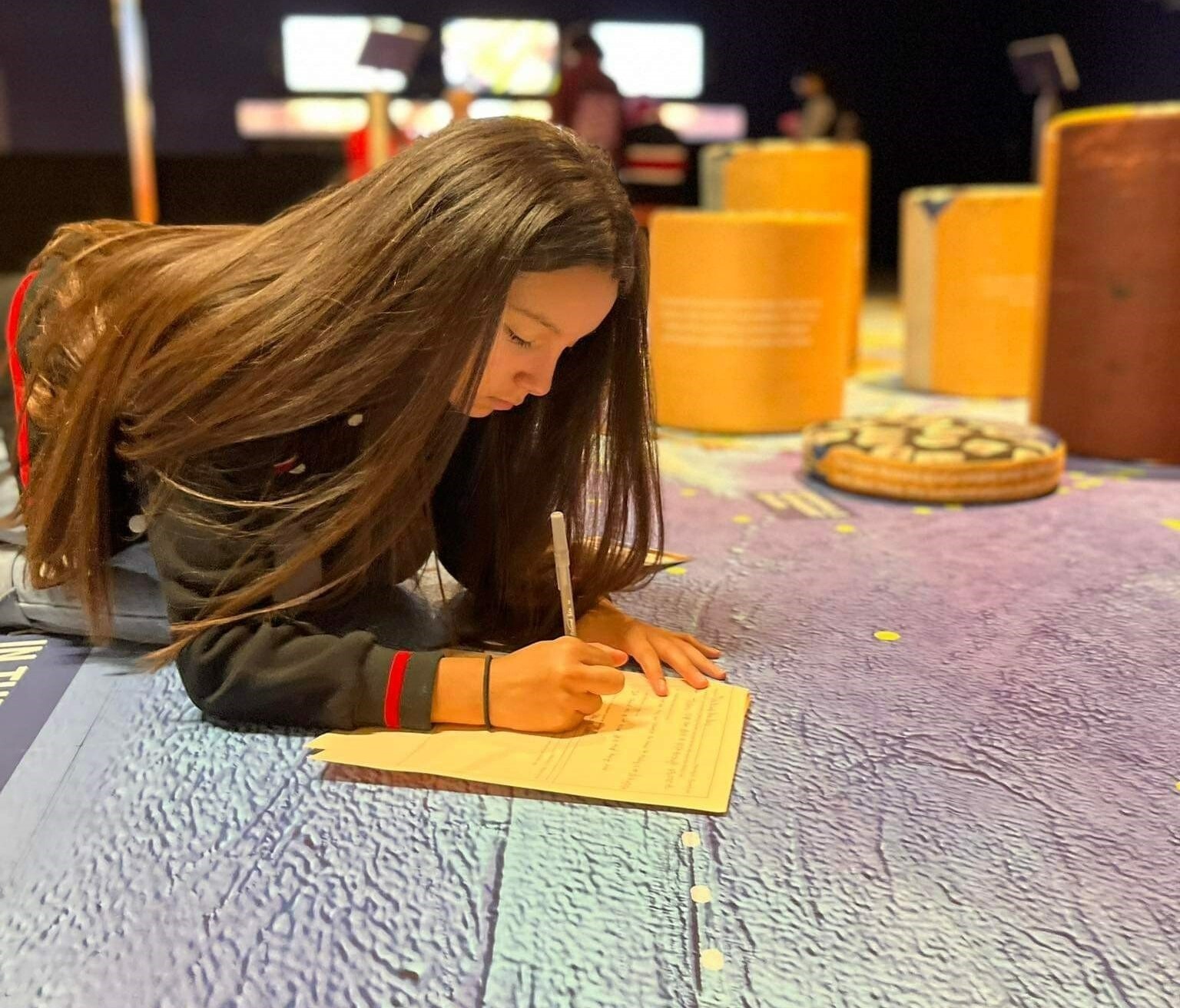
Prior to the exhibit opening to the public, all project participants collaborated on planning activities to pair with each of the exhibit’s components, which was led by the Noyce Scholars. The Noyce Scholars were provided with many supplementary materials. They made some initial decisions regarding which activities would be most engaging and relevant and then sought input from the middle school STEM Academy students. They updated the premade activities from the IODP and created several new hands-on activities. The Noyce Scholars discussed relevant vocabulary and developed probing questions to ask their audiences. Planning meetings took place both during and after school time. The group divided into teaching teams, becoming experts in their kiosk and activities. The cooperating teachers and Noyce INSPIRES team intentionally stepped back and allowed the Scholars and middle school STEM Academy students to lead the planning for how to integrate their learning and best share the In Search of Earth’s Secrets exhibit and activities with their community.
Once the professional development trainings were completed, the Noyce INSPIRES team partnered with the IODP exhibit in facilitating multiple community events. The West Oso ISD elementary school students as well as members of the larger community attended the exhibit throughout a weeklong exhibition. Through this experience, the Noyce Scholars, middle school STEM Academy students, and cooperating teachers learned about and increased awareness of cutting-edge research and STEM career paths, while practicing valuable informal science teaching skills. The kick-off event was an evening family engagement activity. The school events had groups of approximately 40–50 students at a time exploring the kiosks, floor map, and hands-on supplemental activities. During the Saturday event, the community had the opportunity to experience the inflatable ship that featured a three-screen video of geologic time. The Saturday event brought together community members from multiple school districts and private schools across the city. Saturday attendees were provided with a passport card with all of the kiosks (see below). Once they completed each activity, they received a sticker, and each community member that completed all the kiosks received a certificate as they exited.
Description of Kiosks: In Search of Earth’s Secrets
In addition to the descriptions below, the Supplemental Resources In Search of Earth’s Secrets contains additional information about the activities.
Quakes and Waves
This kiosk focused on what earthquakes are, how they affect the environment around them, and what other landforms could be made by the movement of tectonic plates such as mountains, volcanoes, and valleys. For the Earthquake Simulator activity, three aluminum pans contained a layer of fabric and a layer of soil. On top of the soil, building blocks represented buildings. At the table, students stood across from each other with the pans between them. Students grabbed one end of their “tectonic plate” and pulled it toward them. In that process, the “buildings” would shift and fall over.
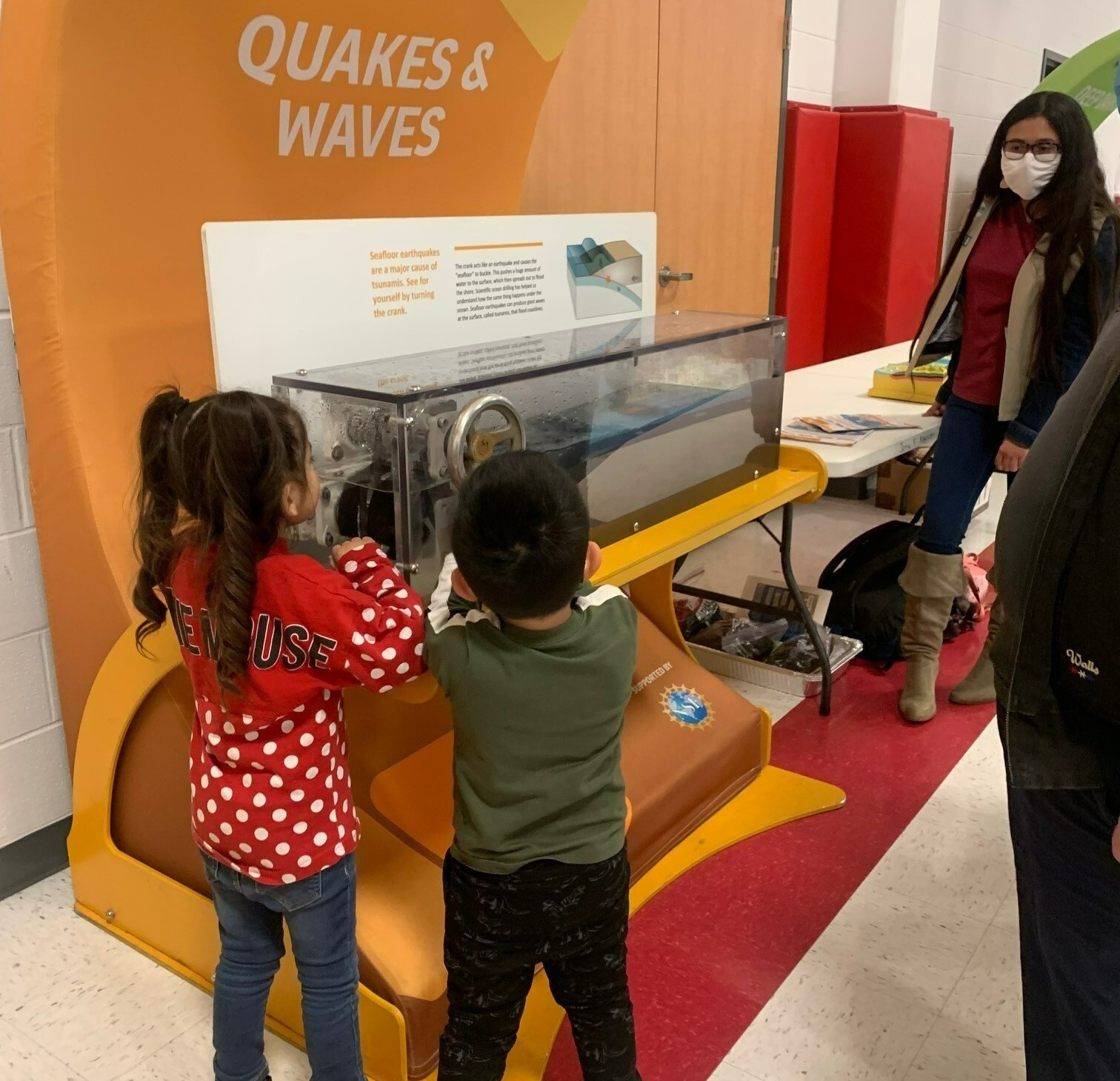
Drilling the Deep
This kiosk contained paper plates with three Dixie cups, each filled with different substances: packed soil, sand, and marshmallows. The students learned that two distinct kinds of drill bits were used to extract core samples, depending on seafloor material. The “drill bits” for this activity were golf pencils (a sharp side and a blunt side), straws, craft sticks, and chopsticks. Students explored materials to determine which drill would be most effective.
Dino Doomsday/ Geology Under the Sea
This kiosk included a floor puzzle map of the Earth. On this map, the students saw where the asteroid that struck the Earth and killed the dinosaurs landed, different core extracting sites, location of tectonic plates, volcanic hotspots, and other interesting facts about landforms. The floor map came with its own activity: the geological time scale pillows. The students were tasked with stacking the pillows based on the timeline printed on their sides. As a supplemental activity, students put together a mini puzzle of the tectonic plates.
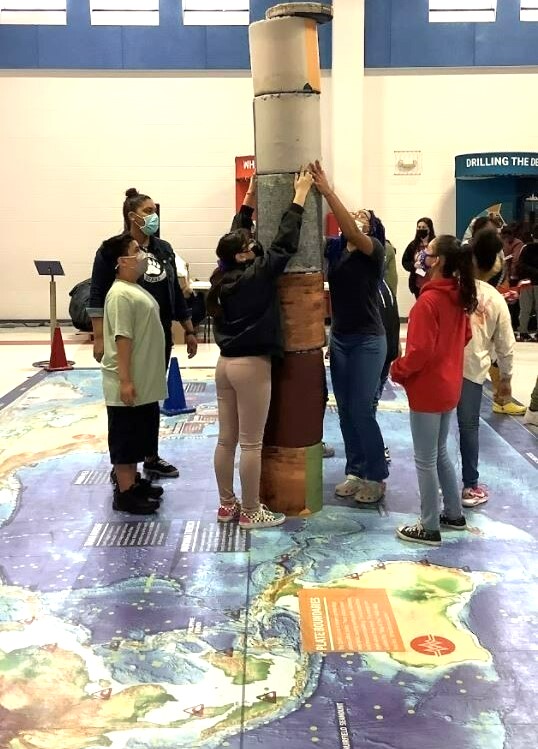
Deep Dark Life
This kiosk explored microbes that live in the ocean seafloor and how the energy levels are transferred from the top to the bottom of the ocean floor. For this activity, the students observed different pictures of microbes and pictures of microbes in petri dishes with sand and soil to simulate the ocean floor.
Deep Sea Fossils
This kiosk explored microfossils found deep inside the extracted core samples. Students observed images of the different microfossils discovered similar to the activity we had for Deep Dark Life. Students used toothpicks and cotton swabs to “excavate” the chocolate chips embedded in the dough.
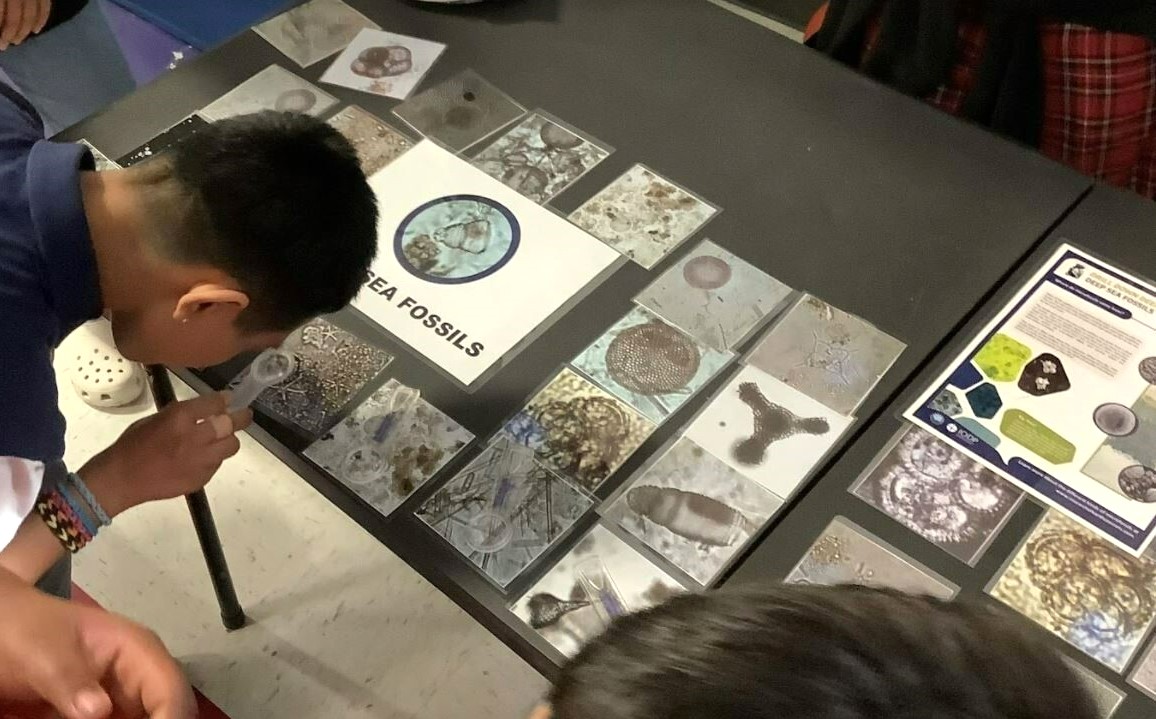
What is a Core?
This kiosk explored the geomagnetic field reversal that can be observed by the sample core provided. For this activity, students explored a variety of magnets and their properties.
Project Details
The Noyce INSPIRES team was pleased with the attendance showing interest in the science of the Critical Service Learning Project.
JOIDES project attendance numbers
- Kickoff event: Seventy-five participants ranging from kindergarten through second grade students and their parents.
- Elementary Classes: Five hundred students in grades preK through second grade attend West Oso elementary school. Students were brought to the exhibit with their teachers during the school day. In addition, seven classes of fifth graders were brought to the exhibit with their teachers during the school day.
- Community members: The 150 families included community members that brought their children. These 150 participants included not just families from West Oso ISD but from surrounding districts and homeschool students.
- Middle School Students: Twenty-two middle school STEM Academy students received training to serve as facilitators for the kiosks at each event.
Time requirements
The total time involved for this event was as follows:
- The first event was two hours: 5:30–7:30 pm.
- The school day events were a total of 10 hours, split between two days.
- The Saturday event was from noon to 3:00 p.m.
Lessons Learned
Noyce Scholars were encouraged to reflect on their abilities to translate the critical service learning experiences into culturally responsive pedagogy for their own professional practice. While both the STEM Academy middle school students and the Noyce Scholars engaged in professional development and training in science content knowledge, both participant groups would have benefitted from more explicit instruction in best practices for science pedagogy with a focus on early childhood learners. In written reflections, both groups shared their struggle with how to adjust their explanations of the scientific concepts to the various age levels that attended the events. Using scientifically accurate vocabulary is essential, but this vocabulary needed to be connected to the students’ background knowledge. In future critical service learning activities, the STEM INSPIRES team plans to provide opportunities for the Noyce Scholars and STEM Academy students to have multiple opportunities to role-play facilitating activities and fielding questions. These practice sessions would include time for feedback and reflection, so that students could refine their instructional practices.
Several of the Noyce Scholars and STEM Academy students reflected that they did not anticipate how long it would take to set up kiosks and prepare materials. Allocating more time for setting up and having back-up supplies provided further lessons learned.
During the two days of having large groups attend the exhibit, learning could have been enhanced by more structured rotations. West Oso ISD students were allowed to circulate freely with adult supervision but were not given specific guidelines on how much time to spend at each kiosk. Having specific rotation schedules would have allowed for more in-depth investigation, explanation, and questioning.
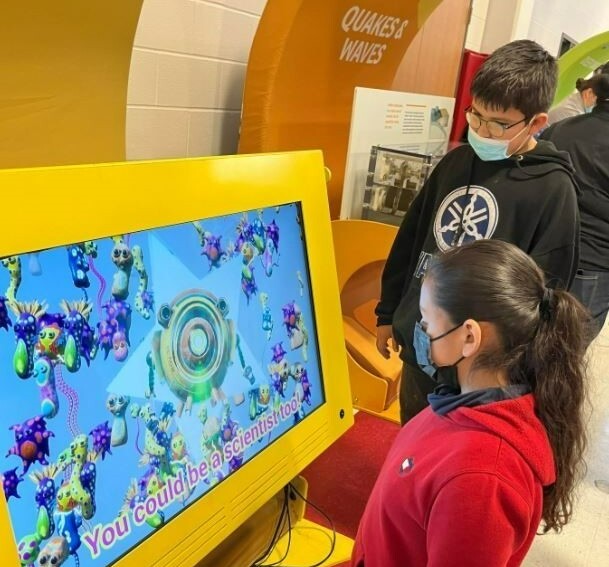
Impact
In Search of Earth’s Secrets followed a model providing on-site, intentional community and field experiences within a collaborating Title I school district. To develop teachers with improved skills in culturally relevant teaching, the Noyce INSPIRES program supported an inclusive culture of STEM success by developing STEM talent and achievement through authentic and relevant experiences involving grades 7–12 students and teachers in economically disadvantaged urban schools. Our vision is for Texas A&M Corpus Christi to develop culturally responsive STEM secondary teachers. Collaboration is a core skill developed for all stakeholders in this project. Together, the Noyce Scholars, classroom teachers, and middle school STEM Academy students acquired scientific knowledge, brainstormed how to share most effectively what they learned, and then labored to implement their ideas.
An outside evaluator of the Noyce grant collected in-depth, semi-structured interviews with graduating Noyce Scholars to explore critical service learning and the collaboration of a West Oso ISD. The report states several Noyce Scholars enthusiastically reported participating in the In Search of Earth’s Secrets traveling exhibit for elementary students and the community. They reported that they volunteered after hours, and “I really think that the most powerful thing we did as a Noyce group was to go out there and just plug ourselves directly into the community on a Saturday, with all our students. We developed displays and activities regarding deep sea research for the event, which was held on a Saturday at West Oso Elementary School.” Another Noyce Scholar explained:
We made activities, we organized all these different things together, and got students all involved, and had this huge celebration. It was kind of like a Science Kick-off Day with parents and families. And, of course, the school district is very tiny, so everybody knew each other and also it was nice to see that sense of community, as well.
Collaboration through critical service learning allowed the participants opportunities for both teaching and deep learning, which helped develop culturally responsive STEM secondary teachers. The Noyce Scholars—along with the middle school STEM Academy students—took leadership positions, identified their strengths and interests, and self-evaluated while developing meaningful relationships along with their scientific knowledge. In a final self-reflection where participants were asked to evaluate themselves on their knowledge of the ocean, 75% of them rated their knowledge of ocean drilling as increased. The trainings, hands-on activities, and scientific investigations that all team members experienced prior to the events gave them the confidence to serve as effective facilitators. The elementary students that attended were excited to learn from their sisters, cousins, and neighbors. The middle school STEM Academy students began to have a vision for themselves as STEM professionals, while serving as a role model for the younger learners. Instead of STEM being something they read about in a book or see in a museum or on TV, it was something in which they actively participated by incorporating critical service learning.
Acknowledgments
This material is based upon work supported by the National Science Foundation (NSF) under Grant No. 2050588 and 1515856. Any opinions, findings, interpretations, conclusions, or recommendations expressed in this material are those of its authors and do not represent the views of the National Science Foundation.
Dr. Faye Bruun is a co-PI of Noyce INSPIRES Grant at Texas A&M Corpus Christi, COEHD; Katherine Dion, MS, is the Project Manager at Texas A&M Corpus Christi; Kimberly Moore is the Superintendent at West Oso Independent School District; Dr. Robin Johnson is a a co-PI of Noyce INSPIRES Grant at Texas A&M Corpus Christi, COEHD; Dr. Cherie McCollough is the PI of the Noyce INSPIRES Grant at Texas A&M Corpus Christi COS; Dr. Carmen Tejeda-Delgado is co-PI of Noyce INSPIRES Grant at Texas A&M Corpus Christi, COEHD; all in Corpus Christi, Texas.
Citizen Science Earth & Space Science Preservice Science Education Teacher Preparation Pre-service Teachers Informal Education


